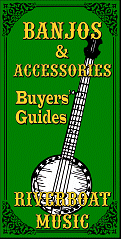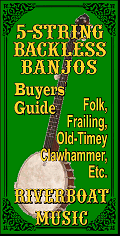Acoustic Instrument
Primers
What Kind of Guitar
Should I Start On?
What Kind of Banjo
Do I Want?
Evaluating and
Buying Used
Guitars
Setting Up
Fretted Instruments Whatever Happened
to the Banjo?
Beginning Five-
String Folk Banjo
6-String Banjos
Banjo Pickups
Axes in my Life
What is a
Bluegrass Banjo?
Dean "Backwoods
Six" Shootout
What is a Zither Banjo?
Music Theory
Primers
Introduction
to Scales
Introduction
to Chords
Circle of Fifths
Other Articles
About Music
How to Give
Guitar Lessons
Musician or
Wannabe? Did God Really
Give Rock &
Roll to You?
Are You a
"Brand Bigot"?
Who Owns Folk Songs?
Historical Links
About the
National Road
The Story Behind
the Story - Real
People, Places,
and Events
About the Play
Play Home
What's New
Overview
About the
Music
About the
History
About the
Logistics
About the
Cast
Synopsis
About the
Set
About the
Author
Contact Us
Home

Lesson 1e: Your First Chord Progression
| Edited by Paul Race for Creek Don't Rise? |
|
Editor's Note: Between 1999 and 2004, Mitchel "Mickey" Cochran posted an extensive collection of free musical instrument lessons on his FolkOfTheWood.com web page. Sadly, we lost Mickey in 2011. After e-mailing surviving family members for permission to repost some of Mickey's most popular materials, we have begun restoring them to host on these pages. (Please see the Introduction page for more information on that effort.) This page is Mickey's explanation of hot to get started learning chords on the 5-string banjo tuned in "Open G Tuning," the Bluegrass favorite. - Paul Race |
Lesson 1e: Your First Chord ProgressionThis G Chord Progression will be your first attempt in trying to coordinate your left hand while strumming with your thumbpick. Go slowly at first until you feel comfortable enough to speed up. Your first step in learning this chord progression would be to memorize the chordal position themselves...notice the chord diagrams above the standard notation in the following example...place your fingers matching the dots on the diagrams. Notice the "O" above the chord diagram...this means that the string is to be played open...if there's an "X" this means that string is deadened or not to be played. After becoming familiar with the chord diagrams, and feeling like you've memorized them all, then follow the four slashes in the standard notation and tap your foot with each beat...while counting to four from measure to measure. Symbols for the picking hand are indicated above the tablature using the following letters: First Finger (Index) = I In the following exercises, you'll notice that only a "T" is indicated above the tablature...this means you're only to strum each chord with the thumb...follow the slashes "/" in the standard notation to count to four for each measure. Try tapping your foot to keep an even tempo with each count of four. Try switching the chords without any pauses as you count out this rhythm. The goal is to keep an even tempo and to establish the chord progression without pause or hesitation. Once you can accomplish these exercises, you will then be ready to go on to applying rolls to these very same chordal studies...
Further down the page, Mickey shows a B chord that is actually played by fretting the strings just behind the fourth fret. I do that by laying my forefinger across the neck there hard enough to force all of the strings down. But you can try fretting the strings individually. Again, the x on the fifth-string means "don't play the drone string or let it ring."
Practice this progression over and over and over...don't give up. Enjoy the learning process...have patience with yourself. Upon learning this progression, and being able to play it comfortably without pausing between chords, you'll be prepared to learn your first song. Copyright ?1999-2004 Mickey Cochran |
Conclusion
Mickey's instructions are as valid today as when he wrote and recorded them years ago. Here's hoping that you find them just as helpful as his original followers did back when he was interacting on a daily basis with his them.
Please contact us if you're hitting any brick walls and we'll try to help you get therough them.
Best of luck, all, enjoy your music, and support the arts.
Paul Race
And when you're ready to move on, click here to go to the next part of this online lesson.

|

|


All text and any illustrations and/or videos within the white box above are copyright 1999-2004 by Mitchell Cochran. All other materials, illustrations, and content on this web page, including the text reformatting and illustration restoration within the white box are copyrighted ? 2016 by Paul D. Race. All rights reserved.
Creek Dont' Rise(tm) is a participant in the Amazon Services LLC Associates Program, an affiliate advertising
program designed to provide a means for sites to earn advertising fees by advertising and linking to Amazon.com.
For questions, comments, suggestions, trouble reports, etc. about this page or this site, please contact us.
| Visit related pages and affiliated sites: | |||||
| - Music - | |||||

|
 |
 |

|

|

|

|

|

|

|

|

|

|

|

|

|

|

|
| - Trains and Hobbies - | |||||
 |

|

|  |
 |

|
| - Christmas Memories and Collectibles - | |||||
 |

|
 |

|
 |

|
| - Family Activities and Crafts - | |||||
 |

|

|

|

|

|

 Note from Paul: Hope you're not getting tired of these little interruptions. In the following illustration, Mickey shows a kind of D chord he doesn't really explain. When he writes "2nd fret" next to the top of the little chord chart, he is saying that what looks like the first fret on the chart doesn't represent the "nut" as it usually does in these charts - it represents the second fret, so the chord is really two frets up from where it looks like it should be. The way I play a D chord is shown at the right, if that helps. Mickey adds another note that is fretted, which is useful for melodic playing. In addition, the little x means that you don't play the drone string with this chord.
Note from Paul: Hope you're not getting tired of these little interruptions. In the following illustration, Mickey shows a kind of D chord he doesn't really explain. When he writes "2nd fret" next to the top of the little chord chart, he is saying that what looks like the first fret on the chart doesn't represent the "nut" as it usually does in these charts - it represents the second fret, so the chord is really two frets up from where it looks like it should be. The way I play a D chord is shown at the right, if that helps. Mickey adds another note that is fretted, which is useful for melodic playing. In addition, the little x means that you don't play the drone string with this chord.
